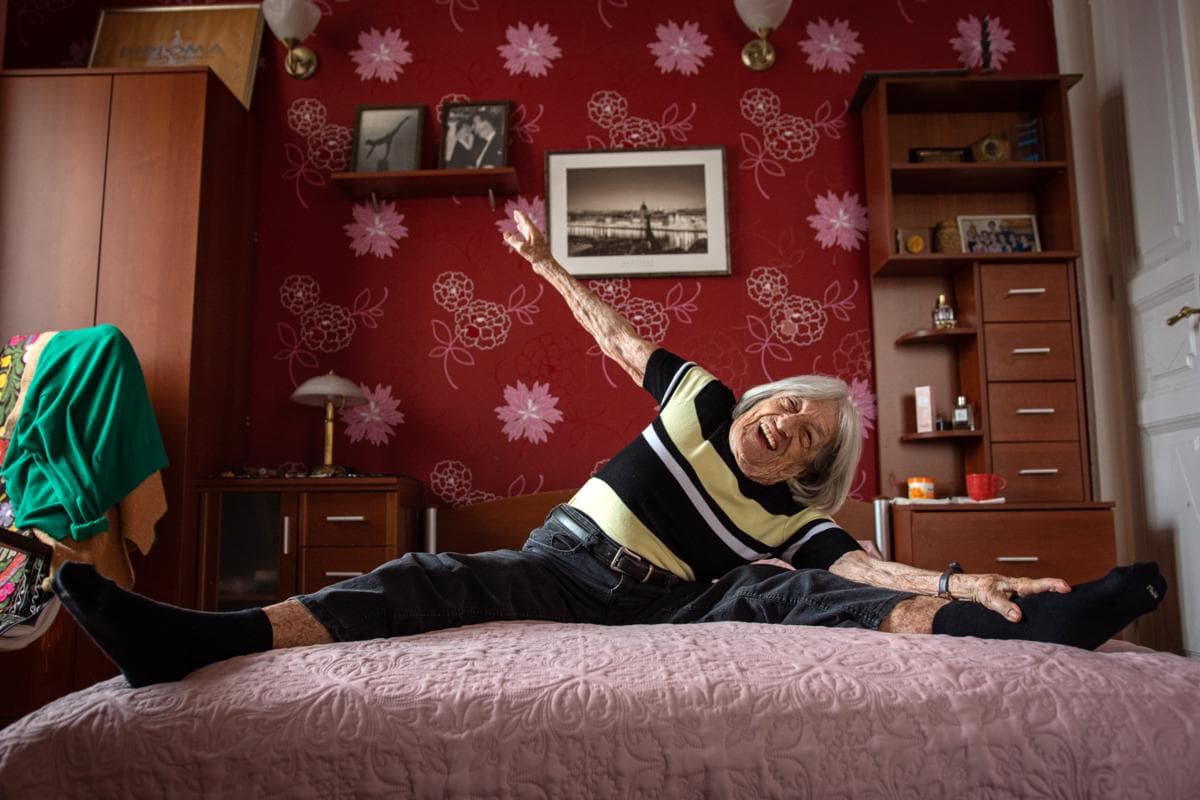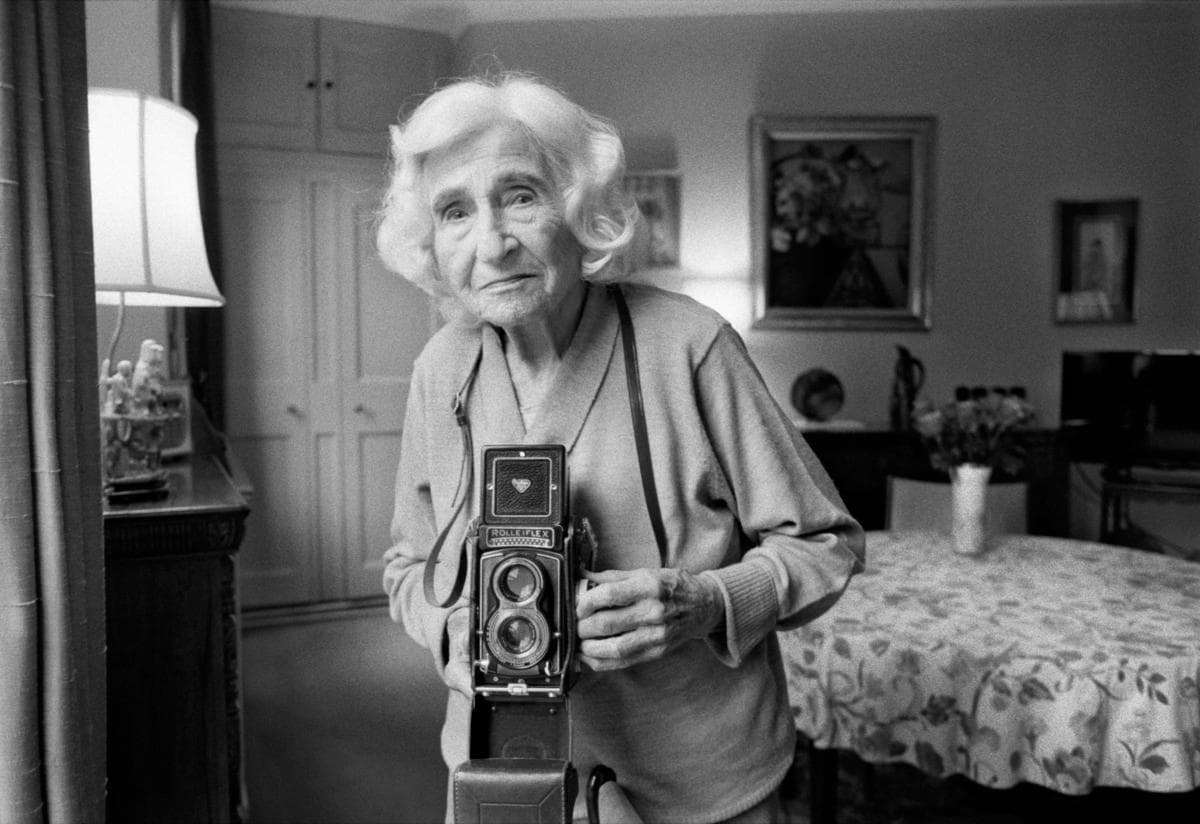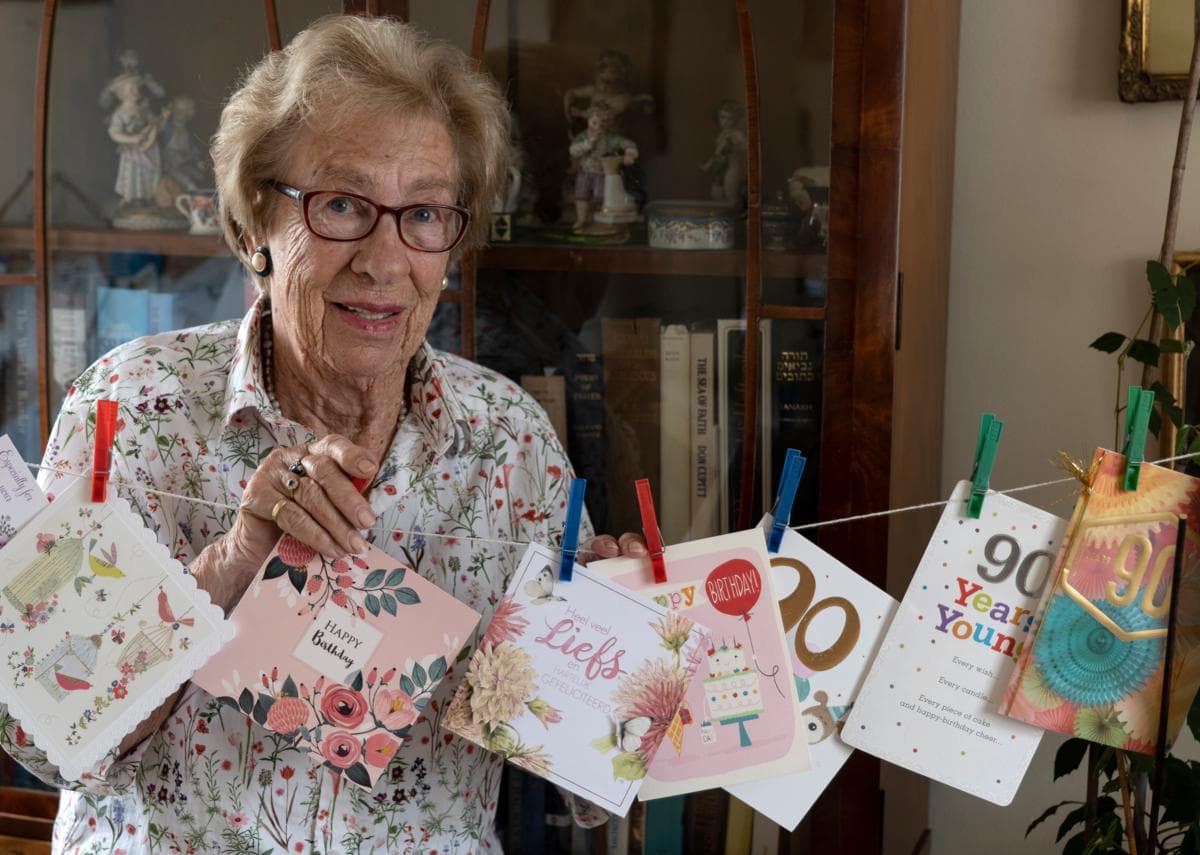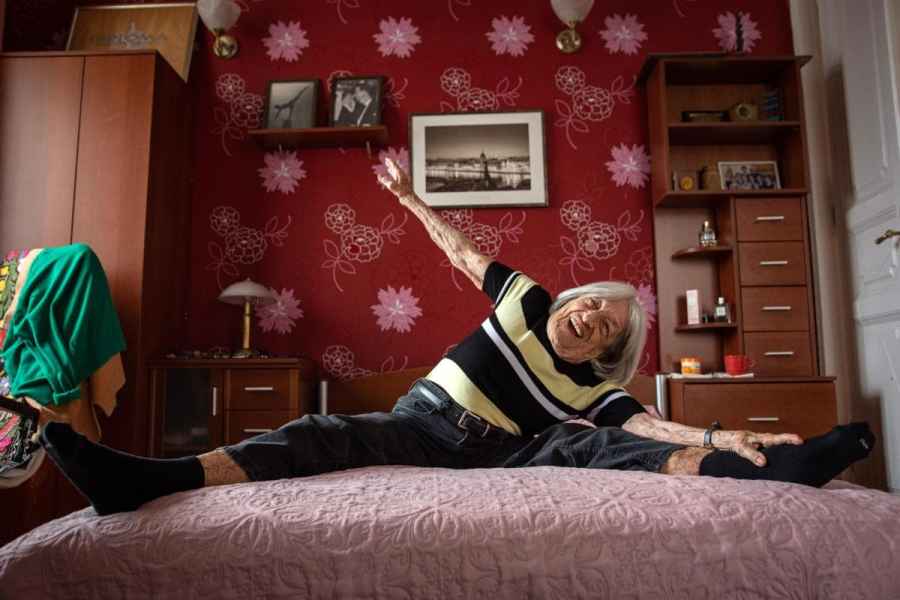
Hungarian Olympic champion, the artistic gymnast Agnes Keleti, who was born in Budapest in 1921
‘We were watching TV, December 2018, there was a report on [American news channel] CNN. They’d done a survey in France and found that around 15% of French people had no idea what the Holocaust was, which was very shocking to both of us. We watched this and thought how can this be? France was occupied by the Nazis for four years during the war and split the country up, so we just started thinking what can we do as photographers to remedy this as a way of Holocaust commemoration and remembrance, to increase awareness in an educational capacity?’ explains Jim Hollander speaking on the phone from his home on the outskirts of Jerusalem, Israel. Equally astounding, in a recent report by Claims Conference: ‘While there were over 40,000 concentration camps and ghettos in Europe during the Holocaust, almost half of Americans (45 per cent) cannot name a single one – and this percentage is even higher among Millennials.’
Jim and his wife, Rina Castelnuovo, are both professional photographers. Now 70, Jim has worked for United Press International, European Press Agency and Reuters. Rina has photographed for The New York Times in Israel since the mid-nineties, as well as Time magazine, Stern, and the Associated Press previously. As well as news, both have covered Holocaust survivors and associated events in Israel. They hit upon the idea of reaching out to the community they knew, at first photojournalists, asking them if they could volunteer to do a portrait of a Holocaust survivor. The response was overwhelming. No direct guidance was given except to avoid a simple headshot. ‘What struck us is that the survivors have a powerful will to live that many people don’t have. They survived such horrendous years of torture and suffering and they’re powered to get on with life and to live and enjoy it. We expressed that to the photographers – we’d like a portrait of their power to live.’

Four Holocaust survivors who do not know each other show their tattoos

Jim Hollander hanging photo panels from The Lonka Project at UN headquarters in New York City, 23 January 2020
The number of portraits received is heading towards 250, taken by some of the world’s leading photographers including Roger Ballen, Stuart Franklin, Steve McCurry, Gilles Peress, Alec Soth, Peter Turnley, Heidi Levine, Jane Evelyn Atwood, I could go on. The collection is called The Lonka Project, a tribute to Rina’s mother, Dr. Eleonora ‘Lonka’ Nass (1926-2018). It’s a compelling testament to the power of living. Attara and Yosef Dekel, photographed in Hadera, Israel, touch hands sat on a bed surrounded by stuffed soft toys. Adam Han-Górski poses wearing sports kit at an outdoor gym in Plymouth, Minnesota, USA. Hungarian Olympic gymnastics champion, Agnes Keleti, stretches on her bed at home in Budapest, her legs as wide as her grin. Anne Frank’s stepsister, Eva Schloss, is photographed in London stood by a string of 90th birthday cards. The Lonka Project isn’t trying to photograph Holocaust survivors across the globe but a few countries remain important and elusive; a survivor can’t be located in Spain, a few survivors live in Portugal but a photographer hasn’t been assigned.
Favourite portrait
Has Jim a favourite portrait from those submitted so far? ‘There’s one I thought very lovely that I would consider for the cover of the book [there are plans for a book, hopefully by the end of 2020; a German publisher Jim met at Paris Photo has expressed an interest]. It’s by Marissa Roth, who photographed Dorothy Bohm – herself a doyenne of British photojournalism – in London. Bohm, who is in her late 90s, was friends with Henri Cartier-Bresson and the Magnum crowd in the late 1940s. She was a survivor, her parents were able to get her out of Europe and bring her to London.’ Bohm was closely involved in founding The Photographers’ Gallery, London, and has published over a dozen books. In 2009 she was appointed Honorary Fellow of the Royal Photographic Society. Her portrait has her stood stoically behind her Rolleiflex camera.

Dorothy Bohm was born in 1924 in Königsberg, East Prussia

Adam Han-Górski was born in 1940
in Lvov
Alongside each portrait is an accompanying story which explains the context. Some are vague in detail, others are devastatingly poignant. Ralph Hakman photographed by Barbara Davidson: ‘Ralph regularly observed his SS supervisor driving to the crematoria in a Red Cross van, donning a mask and emptying three canisters of Zyklon B crystal pellets into designated ports. Ralph heard the screams of the dying Jews, and then 15 minutes later, when the doors were opened, he saw the bodies tumbling out.’ Miriam Ziegler photographed by Moe Doiron: ‘When Miriam was nine, all prisoners were put on cattle cars and deported to Auschwitz where Miriam was separated from her parents. Her father was killed in the gas chambers. Miriam was tattooed with the number A16891, shaved and was kept in the barracks where experiments were performed on the children. Miriam managed to survive until Auschwitz was liberated on January 27, 1945.’ Film director Roman Polanski, is casually snapped by Franck Leclerc, a jacket hooked over his shoulder. ‘Roman’s mother, Bula, expecting a child, was taken from her family and sent to death in the gas chambers of Auschwitz.’ The stories are distilled horrors of man.
Many of the portraits show the survivor with their identification tattoo but not every survivor portrait is from the death camps. Photographers can interpret holocaust survivor as they like. The Lonka project includes people who were hidden underground, in forests, homes, monasteries, nunneries, and fled to other countries. Ben Frenecz, photographed by Andy Anderson, is not a Holocaust survivor but he is responsible for hundreds of thousands of survivors. Born in Hungary on 11 March 1920, Frenecz was an investigator of Nazi war crimes after World War II, becoming Chief Prosecutor for the United States at the Einsatzgruppen Trial, one of the 12 military trials held by the U.S. at Nuremberg, Germany. All of the 22 men on trial were convicted: 13 received the death sentence, four were implemented. This wider range of stories increases the educational value of the project.
Photographers contributing to The Lonka Project have clearly been affected – as Marty Umans recounts in her experience photographing Samuel Beller, aged 94, at his home in New York: ‘I had a very emotional shoot yesterday. In working through the weeks and process of setting up this portrait session I had not given much thought to what to expect emotionally when talking and spending time with our subject. I have travelled the world and photographed children in Africa for Operation Smile, Ethiopian Jews being resettled in Israel for Hadassah, teens in NYC for Avenues for Justice for over 20 years but never a 94-year-old in Brooklyn who still lives his past like it is today. It was a rewarding two hours spent with an amazing survivor and example of the unsung heroes of the Holocaust. Samuel is open and willing to share his experiences which are horrendous. He lives them every day without the ability to block them out. I did not expect that. It took him decades before he was able to share his experiences but I don’t think it has been a healing, more of a cause, and at 94 he doesn’t have the same energy to share his story. I am grateful for his two hours and cherish my time.’
In total, 93 portraits were exhibited in 100ft of space at the United Nations in New York on 27 January, National Holocaust Day. More exhibitions are scheduled at the Jewish Museum and Tolerance Centre, Moscow, in Berlin, maybe South Africa and other venues around New York. There will be a month-long outdoor show in Jerusalem.

Dr. Moshe Avital was born in 1930 in Czechoslovakia, now Ukraine

Eva Schloss celebrates her 90th birthday
Stressful circumstances
With two photojournalists working in stressful circumstances, I had to ask Jim how they have stayed married for 35 years? ‘We’re both photographers covering the news, we used to work quite a lot together during the First Intifada [Palestinian protests and violent riots against the Israeli occupation of the West Bank and Gaza], and some of the wars, the Scud war in the 1990s. Rina works with The New York Times and I work with Reuters and EPA, so we’re both out covering the story of the day. Israel being a very small country, you can be a conflict photographer on the front line all day long, then an hour and a half later you’re back at home with the kids, you have dinner and forget all about what you saw during the day and you become a family. It’s easy to get back home, so it’s not like you’re away on assignment for months and months at a time.’
Rina’s polish parents were both survivors. It was something that was never spoken about. They used code words when speaking about it with their survivor friends. They never sat Rina and her sister down and explained what they went through, only opening up a little more when Rina was much older on a trip to Poland, visiting family homes and concentration camps, five of which her mother survived including Auschwitz and Belsen.
On 20 March this year, 88-year-old Holocaust survivor Aryeh Even, became the first Israeli to die of coronavirus. Sadly, The Lonka Project has never been more relevant and urgent.
holocaust survivors







